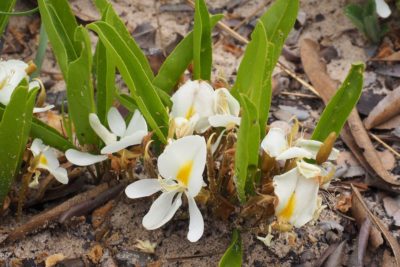As of 2023 just under 400,000 plant species had been discovered. However, scientists estimate a total of 5 to 50 million plant species exist. The number of known species increases every year but the unidentified species are of greatest conservation concern because they are thought to be threatened or even endangered species. Today, we will take a look at 9 plants discovered in 2023.
1. Aeranthes bigibbum

This small orchid is only found among the treetops of a small forest patch in Madagascar. This unique orchid blooms small, translucent, star-shaped flowers.
The only patch of forest where this orchid is found was preserved by local villagers. The villagers manage this patch of forest as a reserve for the endangered helmet vanga (Euryceros prevostii). This reserve, because of the opportunity to see this beautiful bird, is popular with tourists around the world. Fortunately, the creation and management of this reserve, although not the intention, also protected this unique orchid from extinction.
2. Baphia arenicola

This tree from the Angola highlands grows entirely underground, which is a common characteristic among trees in this area. Interestingly, the only visible part of the tree is the small white flowers that blossom just above the surface of the soil.
This tree’s conservation status is considered to be of least concern. There are many individuals of this species documented and it is determined to grow in very nutrient-poor grasslands that are not sufficient for agriculture.
3. Dendrobium lancilabium

One of the more beautiful plants discovered in 2023 is the Dendrobium lancilabium. This orchid is characterized by its bright red flowers. It is endemic to and was found on Mount Nok in Waigeo, Indonesia. Mount Nok is a dormant volcano and this orchid was found while looking for Dendrobium azureum, a blue-flowered species that has not been documented for 4 decades.
Luckily, this orchid’s conservation status is considered to be of least concern.
4. Pinanga subterranea

This palm tree was found in Borneo, a tropical island in Southeast Asia. It is the only known species in the palm to exclusively flower and fruit underground. The palm produces a vibrant red fruit that is a beloved snack among the locals in the region.
This palm’s conservation status is considered to be of least concern. There were many individuals of this species documented and the estimated abundance of individuals is thought to be much higher than previously calculated due to low collection efforts.
5. Nicotiana olens
This new variety of tobacco plant was found in New South Wales, Australia. The plant is characterized by its sweet-scented, white flowers. At the time of writing this post, there was no found information on the conservation status of this species.
Fun fact: Over 50% of all known tobacco plants have been documented in Australia.
6. Microchirita fuscifaucia
This new species of violet was found in south-eastern Thailand. This plant is identifiable by small white flowers with dark purple centers. This species, as well as many other species within its genus, grow on top of limestone.
This violet species is considered to be threatened. Furthermore, The species grows in only two places and both are not environmentally protected. Therefore, the forest where this species grows is likely at risk of being cleared for agricultural purposes.
7. Indigofera abbottii

This new species of indigo-bearing plant was found in South Africa. This species is a shrub identifiable by its protruding T-shaped hairs, cylinder-shaped pods, and pink flowers.
Unfortunately, this indigo-bearing plant species is considered to be threatened. One major issue is that the region it grows in is at risk of being cleared for agriculture and urbanization.
8. Crepidorhopalon droseroides

Another new plant that was discovered in 2023 is the Crepidorhopalon droseroides. This new possibly carnivorous plant is closely related to mint and was found in Mozambique. Additionally, no known species in this genus are carnivorous. This plant can attract and trap insects within its sticky hairs but it is still unknown whether the plant can digest its prey. At the time of writing this post, there was no information on the conservation status of this species.
9. Cochlospermum adjanyae

This tree from the Angola highlands grows entirely underground, and was found on the same expedition as species number two on this list, Baphia arenicola. Furthermore, It blossoms small yellow flowers just above the surface of the ground.
This tree’s conservation status is considered to be of least concern. This species was determined to grow in very nutrient-poor grasslands that are not sufficient for agriculture.
Are you interested in learning more about the wonderful world of plants? Take a look at our articles on the Queen Victoria’s Water Lily or Air Plants!



